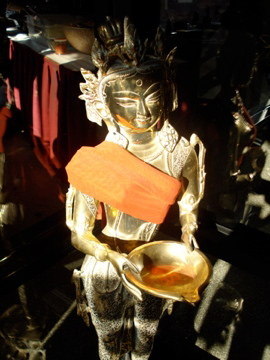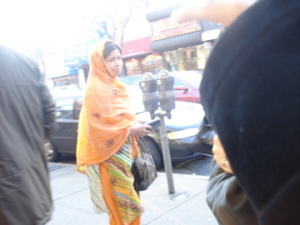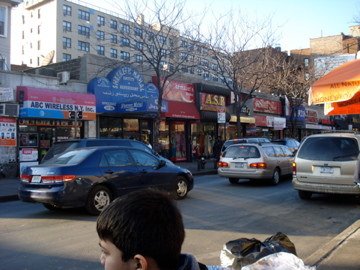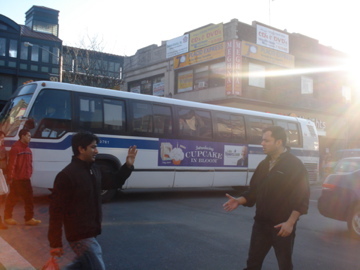From The Peopling of New York City
A Visit to "Jai Kishan" Heights
- On 74th street, "Indianess," as distinct from American lifeways, was visible and audible in stores purveying saris, jewelry, food, music, and movies. -Madhulika S. Khandelwal in Becoming American, Being Indian
While traveling impatiently on the “R train” from Brooklyn to Queens, I skimmed through Khandewal’s reflection on Jackson Heights in “Becoming American, Being Indian.” I was excited to visits Jackson or “Jai Kishan” Heights that was “reminiscent of South hall in London or a shopping bazaar in India” (26). A true “Little India!” Furthermore, I was interested to see the integration of various South Asian groups in America– their relationships in the small area that would possibly intensify the cultural experience. I pictured the area sparkling with mango greens, reds, yellows and other luxuriously hued sarees, shimmering rows of bracelets, and vendors selling spicy samosas and Indian sugary sweets under an Indi-pop musical atmosphere. After a forty-five minute ride, I exited the Roosevelt-Jackson Heights train station onto Roosevelt Avenue, a street that reminded me of a familiar Russian area, Brighton Beach, Brooklyn.
Perhaps, my image of Jackson Height was the American me fantasizing of the richness of color and culture that I have admired in many Bollywood films. The streets were noisy, filthy and bustling with cars and traveling herds of people. The average New York “Hallal Food” carts occupied corners of streets, ethnic and non-ethnic retail and service stores stood cluttered, and the train station created a dim canopy over the area. I remained open minded. The majority of people roaming the street were South Asians visiting other South Asian businesses. I needed to ask the questions: What is being sold here? Who is selling and who is buying? How are businesses and people interacting here? As I closely explored the area from 74th street and 73rd street, still remaining slightly inhibited in this unknown area and focusing mainly on the visual details of the area, a uniqueness and richness of culture became visible in both the economical and business development of “Little Indian” and the people that crowded it’s streets and stores. The uniqueness may not have been the one I was initially envisioning, a “Little India” like the movie posters that covered store fronts, but a more realistic way of life for a South Asian community.
Although I imagined more interplay between Hindu, Bangladeshi, and Pakistani cultures, the sects segregated on separate streets and businesses. A religious conflict and economical disparity seemed to exist between Hindu people, who were store owners, and Muslims, who mostly occupied small street vendors and sold some basic goods along side Islamic texts. Yet, within single stores and groups of stores, existed various subcultures and family interactions. South Asian women occupied the fashion and jewelry stores with their husbands and family members, examining various luxuries: the extravagant wedding dresses and 22 Karat gold necklaces and statuettes decorated in jewels and diamonds. Younger children and mothers crowded around store front toy displays, while older men, sons, and teenagers explored new movies, as South Asian music flared from the back of the multi-purpose stores. Families crowded local ethnic supermarkets, carrying multiple bags with rice, potatoes, and exotic vegetables, like the wrinkled cucumber-shaped Indian melon, Karela. South Asian men greeted each other on the congested streets, a sense of commonality felt from their smiles, handshakes and even similar dress in jeans and leather jackets. And above, on second levels, businesses including driving companies, lawyers, and medical specialists provide services to the South Asians of Queens. Not only did the area offer South Asian luxuries, but facilitated a cultural identity through service businesses. South Asian people working in this ethnic area are not only the merchants and business owners of the area, but are successfully serving their community as esteemed doctors and lawyers.
Amongst the South Asians, white tourists, Spaniard, and other unidentifiable peoples traveled the streets and occupied some businesses. The interplay of South Asians and whites was most evident inside restaurants and the outskirts of the neighborhood. I decided to dine at the famous Jackson Diner to experience one of Jackson’s Heights key points of interest. The population of the diner was mostly white, with a few South Asian families. The food, surprisingly to me, was not as rich in spice and flavor as many of the local Indian places I have been to in Manhattan and the service was less pleasant then I’ve experienced. The men and waiters were rude, the place was noisy, and the Indian vibrant spirit surely was not felt. Exiting the restaurant, and ending my observation of Jackson Heights, I glanced at the T-Mobile cell phone stores, the Payless shoe store, and the Spanish markets and bodegas on the outskirts of “Little India’s” streets. The modernization, diversification and commercialization of the area was there, and although it may have taken away from the “Indianess” of the area, it seemed necessary.
What I’ve absorbed from my first visit is probably a superficial skim of the neighborhood. The area is certainly thriving on South Asian flare and reputation, and although I believe it has been washed down, it continues to be an essential force in Jackson Heights. I hope to learn more from locals and business owners who have seen Jackson Heights change and who have first-hand experiences and feelings of being a South Asian in America.
--shannakofman 15:10, 10 February 2009 (UTC)



